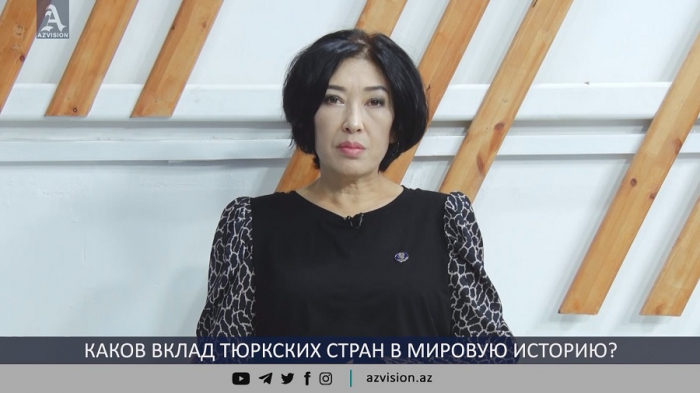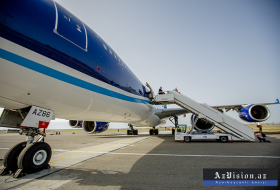The modern image Europe presents to the world is largely based on the achievements and traditions of the Turkic civilization. Having once risen in the steppes of Central Asia and Eurasia, the Turkic world became a crucial component in the political history of all mankind.
There is indeed infinitude of facts testifying to the contribution of the Turkic civilization to the treasury of the entire world. Studies by prominent Western academicians have offered us more than plenty. The greatest achievement of the Turkic people was the first ever writing system, including an alphabetic one, based on the sound principle. The alphabetic writing made it possible to record speech based on the sound method with a minimal quantity of easily and quickly nameable characters-letters. The discovery of the Turkic scripture became a stunning sensation in science. Ernst Doblhofer sincerely wrote: ‘They (Turkic writings) come from an area which was ‘other world’ for all Western cultures. It came from the very heart of Asia and belonged to people, who we knew absolutely nothing about for a long time and still do extremely little. Therefore, they seem so interesting.’
Another quote by him reads: ‘We cannot be indifferent towards the language of the ancient Turkic monuments even now… Having grown up in constant communication with the ancient cultural peoples, these peoples stand at an amazingly high level of development.’ The eminent turkologist Sadri Maksudi said that the writing and developed language of the Proto-Turks mainly pointed at the fact that their material culture and societal organization was apparently more advanced and higher than of others. The Proto-Turks were probably the first in the world to master mass cattle breeding and a nomadic lifestyle using domesticated horses. These skills – revolutionary for the time – allowed the Proto-Turks to live a very dynamic lifestyle, control vast territories, and therefore, understand these lands and amass colossal material values there.
The true civilizational value of the time was not erecting some kind of pyramid or great wall, but the ability to organize large crowds of people into developed nomadic communities with an excellent understanding of the world around them. As a result, they were able to shape a moderately perfect and stable language earlier than other peoples. Being somewhere in the middle of Europe and Asia, nomads acted as a catalyst of sorts – a bridge, which connected various civilizations, cultures, and peoples.
Moreover, we should keep in mind that numerous prominent personalities, Vladimir Vernadsky and Jawaharlal Nehru in particular, acknowledge that the civilizational fusion of the Turkic world and its culture set the launching grounds for developing the Western civilization. These are science-proven facts. Therefore, scientific and historical justice demands one to recognize the contribution of the Turks into the development of European culture and civilization. We must remember this, speak, and write of this to gradually right the historical wrongs and misconceptions triggered by Eurocentrism and class approach. This is crucial for not only Turks. The time has ripened to realize that human civilization does not only comprise the achievements of the West, but also the rest of the world, including Eurasia. Western values are only a part – albeit the most important one – of the universal human experience.
Finally, a few words must be said of the military art of the ancient Turks. The French philosopher Montesquieu spoke of the nomads of the Great Steppe with unveiled admiration in his Persian Letters: ‘Of all the nations in the world … there is none that has surpassed the Tatars either in glory or in scope of conquest. That tribe is the real ruler of the universe. All others seem made to serve it. It is equally founder and destroyer of empires. From time immemorial, it has given proof of its power upon the earth; in every age, it has been the scourge of nations. The Tatars conquered China twice, and they still hold it under their sway. They rule over the vast countries that form the empire of the Mogul. Masters of Persia, they sit upon the thrones of Cyris and of Vishtaspa. They have subjected Muscovy. Under the name of Turks, they have made immense conquests in Europe, Asia, and Africa, and they rule over these three parts of the universe. To speak of more remote times, from them arose some of the races that overthrew the Roman Empire.
What are Alexander’s conquests in comparison to those of Genghis Khan? The victorious nation lacked only historians to celebrate the memory of its marvels. How many immortal feats have been buried in oblivion! How many empires whose very origin we ignore were founded by this race! That warrior nation solely intent on present glory, certain of conquering in every age, never thought of marking itself out in the future by the memory of its past triumphs.’ The French philosopher goes on listing the conquests of Turks known to him, although there are many more, such as the conquests made by Ghaznavids, Tamerlane, Baburids and the Ottoman Empire at the last.
The list is much longer than Montesquieu mentions. All these battles won and countries conquered speak volumes of Turks being unrivalled warriors. Mastery of warcraft and ability to impose their own rules of battle on opponents helped them come out victorious time and again. At the same time, they constantly improved weaponry, warfare concepts, and military tactics. They were the ones, who invented harnesses, introduced light brigades, armoured cavalry, horse formation, new organizations of troops, thus making significant contributions into the international art of warfare.
Russian has adopted many terms from the Turks in numerous fields, from everyday life to trade and warfare, such as чекан (chisel), товар (goods), монета (coin), боярин (boyar), богатырь (bogatyr – akin to Western knight-errand), казна (treasury), штаны (pants), яшма (jasper), аркан (lasso), кисея (muslin), нефть (oil), фитиль (wick), балаган (travelling show), беркут (golden eagle), изюм (raisins), кавардак (mayhem), каланча (watchtower), капкан (trap), караван (caravan), карга (hag), кинжал (dagger), кирка (pickaxe), кузов (wagon body), кумач (red calico), нашатырь (ammonia), очаг (hearth), сазан (carp), сарай (shed), сафьян (Morocco leather), севрюга (stellate sturgeon), сурьма (kohl), табун (herd), утюг (press iron), халат (gown), чугун (cast iron), шалаш (hut), диван (sofa), жасмин (jasmine), каракуль (caracul), киоск (kiosk), софа (sofa), тюльпан (tulip), тюрбан (turban) and many more.
Turks also had their own hierarchy of ranks, military discipline, diplomacy, advanced world view that could challenge the ideological systems of neighbouring countries. Lev Gumilyov proved that military raids were not the only field that occupied the Turks. There were also settled communities, engaged in crafts and trades. The harsh steppe climate allowed them to learn how to make various goods from wool, felt, fur, to develop carts and light mobile dwellings, process iron and raise cattle. Turks were the first in Central Asia to start industrial iron mining (research found traces of extraction of iron ore, tin, gold, silver and others in Altai that trace back to the 6th-9th centuries). This allowed them to win independence and equip their army, as evidenced by written sources and archaeological findings. Turkic blacksmiths made coins, durable knives, axes, sabres, cauldrons, etc.
The Turks have introduced many items of clothing. Their warriors wore special high collar robes, fastened from right to left, headwear with iron plates and fur trimming similar to malakhai (fur cap with large ear flaps), iron plated armour with a belt and trimming, snow leopard skin wide trousers, light and soft black felt boots. The Turkic attire also included combat helmets, skullcaps, and high fluffy hats with bent brims. They wore various kaftans of different patterns and ornaments. Trade, conquests and many resettlements allowed neighbouring peoples to borrow the clothing developed by the Turkic civilization.
The great philosopher who wrote in the fields of political philosophy and logic, Al-Farabi (Alpharabius) studied in Arabic in Bukhara, Damascus, and Bagdad (870-950). He classified scientific study in his Kitab al-Ihsa al-Ulum (De Scientiis). He is considered the founder of logic after Aristotle.
One of the great scientists in Central Asia and the entire East was Abu Rayhan al-Biruni al-Khwarazm (973-1048). The encyclopedist scholar lived in Ghazni and penned 196 works on philosophy, history, geography, mathematics, astronomy, minerology, and physics. He was the first – some 500 years before Copernicus – to prove the rotation of the Earth around the Sun. The great Ibn Sina (980-1037), commonly known as Avicenna in the West, was born in the village of Afshana near the Samanid capital of Bukhara. His formal name in Arabic was Abu Ali al-Husayn bin Abdullah. Avicenna authored a five-volume medical encyclopedia Al-Qanun fi’t Tibb (The Canon of Medicine), Shafa (The Book of Healing), Fisul and many others. He was the only surgeon in the entire East and penned over 250 large works. Mahmud al-Kashgari and Kutadgu Bilig (Blessed Knowledge) by Yusuf Balasaguni have always been considered scientific pearls of the Turkic peoples of the 11th century. Balasaguni delves into the meaning of human life, norms of morality, ancient Turkic legends and folklore. Kutadgu-Bilig is an outstanding work of Islamic Turkic literature, its author a world-class thinker.
Turkic culture has always had individuality: historical data shows that Turks are an original people, who have authored their own civilizations, way of life and their own laws. Representatives of the East, Turks have had a considerable influence on the Western culture. We believe that the Turks comprise the most crucial part of the eastern cultural world. Hence, the Turkic civilization is an integral and significant component of the universal cultural concept of The Orient.
Every nation has its own destiny and history, just as all individuals do. It experiences both rises and declines. At the same time, universal history must preserve the contributions made by every nation, cherish it as a part of world treasury, thereby enriching, and building the foundation for further development and prosperity of universal culture.
Dinara Zhumabayeva, Vice President of Chingiz Aitmatov Issyk Kul Forum, especially for AzVision.az.
AzVision.az Analytical Team
More about:














































